Simon Guerrier's Blog, page 89
March 1, 2013
My first ever rejection letter
Excitement! I have found my first ever rejection letter, received in April 1992 from Gary Russell, then editor of
Doctor Who Magazine
. I was 15 at the time, and it was just a few months since Gary's interview with novelist Paul Cornell (in issue #181, December 1991) had made me realise that being a writer was something I might actually do, not merely something to dream of like being an astronaut or pop star.
I sent Gary a terrible short story in which the Fourth Doctor and Romana land somewhere and, er, that's it, and surprisingly the response was a form letter:
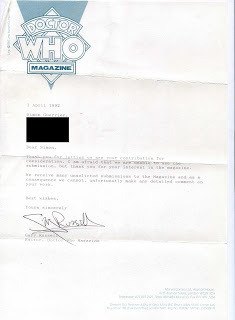
I've had a lot of form letters since. They're the usual response to unsolicited on spec submissions. It took me a long time to realise that collecting rejection letters - forms ones, then form ones with notes on your submission, then ones with notes on your submission that invite you to try again - is a big part of being a writer.
I mustn't have been too disappointed by this first response as I sent Gary more stories. You can see how much better they were by the response I got six months later:
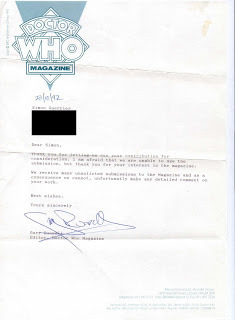
At the same time I also sent a script for a Judge Dredd story to 2000AD , and the form rejection letter I got back wasn't even signed (though someone had asterisked the paragraphs I should pay attention to).
Over the next few years, I continued to send things to Doctor Who Magazine and 2000AD, and also sent in proposals anywhere else I could think of. My first rejection letter from the publisher of Doctor Who books in 1994 was so detailed, generous and encouraging that I probably owe my career to it.
I finally got commissioned by Doctor Who Magazine at the end of 2001, with a two-part feature published in early 2002. Later that year, I also got commissioned to write a Doctor Who short story, in Big Finish's Short Trips: Zodiac. That was edited by Jacqueline Rayner, overseen by Gary Russell. That led to me writing lots for Big Finish, and a couple of years later I helped Gary write form letters in response to submissions.
2000AD turned me down, again, with a form letter just last year.
(Thanks to Gary for permission to post these.)
I sent Gary a terrible short story in which the Fourth Doctor and Romana land somewhere and, er, that's it, and surprisingly the response was a form letter:

I've had a lot of form letters since. They're the usual response to unsolicited on spec submissions. It took me a long time to realise that collecting rejection letters - forms ones, then form ones with notes on your submission, then ones with notes on your submission that invite you to try again - is a big part of being a writer.
I mustn't have been too disappointed by this first response as I sent Gary more stories. You can see how much better they were by the response I got six months later:

At the same time I also sent a script for a Judge Dredd story to 2000AD , and the form rejection letter I got back wasn't even signed (though someone had asterisked the paragraphs I should pay attention to).
Over the next few years, I continued to send things to Doctor Who Magazine and 2000AD, and also sent in proposals anywhere else I could think of. My first rejection letter from the publisher of Doctor Who books in 1994 was so detailed, generous and encouraging that I probably owe my career to it.
I finally got commissioned by Doctor Who Magazine at the end of 2001, with a two-part feature published in early 2002. Later that year, I also got commissioned to write a Doctor Who short story, in Big Finish's Short Trips: Zodiac. That was edited by Jacqueline Rayner, overseen by Gary Russell. That led to me writing lots for Big Finish, and a couple of years later I helped Gary write form letters in response to submissions.
2000AD turned me down, again, with a form letter just last year.
(Thanks to Gary for permission to post these.)
Published on March 01, 2013 02:13
February 26, 2013
On finishing a notebook
Last night I finished a notebook I've kept since 29 December 2011 (when I was in Egypt). I've kept notebooks since I was in my teens, and find them very useful to refer back to – pinching ideas from my past to pitch anew to unsuspecting bosses. It's not a diary, but flicking through this latest volume reminds me what I was working on and having ideas about, and what preoccupied the insides of my head.
There are the day-to-day notes as I wrote one novel, 10 plays and three short films, marking down new clever wheezes or things I'd need to go back and fix. There are pitches for yet more plays, films and comics, notes on what I was reading or watching (much of it later blogged here), fragments of conversation – real and imagined – and turns of phrase or interesting words or ideas.
As an insight into the terrible mess of my brain, here is a selection:
21/1/12Lord Wallace of Tankerness is asked if he knows of a case of suicide in a young offenders' institution and responds, “I associate myself with expressions of regret” - [House of Lords, 24/1/12; col. 987.]
12/5 Page 21 of A Bullet in the Ballet (1937) refers to “con. men” - NB the full stop.
UndatedDo we know what we vote for? Have we read the manifestos, interrogated the data and understood the arguments? Generally, no; we are lazy. We buy newspapers and follow Twitter accounts that confirm our opinions. We avoid complex or counterintuitive issues and the testament of evidence in favour of the glib and easy. We elect a smile, a soundbite, a cipher, not a problematic and uncertain truth. Rule so we don't have to think about it – that is your mandate, nothing more.
10/6Doctor Who - The City in the Clouds ([Rough idea for a Companion Chronicle set in Season 1, but beaten to it by clever Jonny and his Voyage to Venus )In space, maybe on zeppelins linked together to create a city in the temperate zone on Venus – a city in the clouds. All a bit Dan Dare(which Ian has read, confiscated from his pupils), and they realise that this futuristic world is in the early 17th Century, the same time as Galileo is on Earth recording the phases of Venus for the first time. Barbara falls in love and Ian has to take her back to the TARDIS (he uses her mum Joan to convince her to leave). Her lover will think she died. They have to get down to the planet's surface – the hottest place in the Solar System – to recover the TARDIS. Need local people's help. They don't use money there, it's all about reputation and respect – like crowdsourcing, or your number of followers on Twitter. So the Doctor and Susan etc. have to be storytellers, scientists, busking their way in the society, getting themselves known – and only for the right reasons. Loss of face can ruin everything. That's where we meet them at the start of part one, the Doctor as a Punch and Judy man. [Before I knew about Jonny's story, I realised that was too much like Patrick Troughton's role in The Box of Delights before I knew Matt Smith would do some Punch and Judy business in The Snowmen.]
21/8Video going round of a guy mocking iPhone users for taking photos of their food. We're often fooled into thinking we're part of something because we consume it. There are all the tweets and fan activity involved in watching a TV show (a passive experience), or the adverts that sell the idea that by eating a burger or drinking a fizzy drink we're part of the Olympics.
21/10After the accident, people would say to him, 'Do you dream you'll walk again?' And he would consider – as if it were the first time he'd been asked – then say, 'No, only of being able to fly.'
14/11We used to tease herThat in the freezerBelow the croquettes and fish fingers and peasShe kept the bodies of one or two geezersWho thought they'd got luckyWhen she invited them home.
But we were very wrong -It wasn't one or two.
Something inside herMoved like a spiderSpinning them in and dispatching themThen cooking them up for her guestsDespite her reservations that these menCould be counted as fair trade.
She liked the big-boned onesWho made lewd remarksAnd promised not to treat her respectably.Their steaks were good for marbleisingAnd she saw putting them on the menuAs a service to women her age.
27/12Rewatching The Snowmen . Why does Madame Vastra look a bit different from how she did in A Good Man Goes To War ? She's a lizard and sheds her skin, so looks a little different after each shedding. (Also, it's considered rude to point that out.)
4/1/13Billy Connolly, interviewed by Mark Lawson, describes “middle class” as “the kind of people who had dressing gowns as children”.
7/1Michael Rosen on Radio 4's Word ofMouth investigating stenography and Hansard (in the Commons). Stenography machines are phonetic and you press keys simultaneously. Need 200+ words a minute to be accurate and keep up with speech. Some stenographers are certified to 250 words. The quality is “down to a price, not up to a standard”.
Published on February 26, 2013 03:43
February 19, 2013
Three forthcoming conventions
I shall be escaping my writing hutch next month to do some showing off. Why not come along and say hello?
Saturday 16 March: Blue Box 2, Tunbridge Wells
Starring Leela, Mike Yates, Dorium, K-9 and the insides of the Daleks. I'll be there with Brother Tom to show and discuss my short films Revealing Diary and The Plotters .
Saturday 23 March: Big Finish Day 3, Barking
Starring the Fourth Doctor, his granddaughter Susan, Professor Litefoot and K-9. I'll be there in the afternoon.
Sunday 7 April: Phonicon, Exeter
Starring Lord Edward Dark and the insides of the Daleks. Again, I'll be showing and talking about my short films.
Also, clever Ed Stradling filmed highlights of the Gallifrey One convention in LA this weekend, which have only made me all the more miserable not to be there.
Saturday 16 March: Blue Box 2, Tunbridge Wells
Starring Leela, Mike Yates, Dorium, K-9 and the insides of the Daleks. I'll be there with Brother Tom to show and discuss my short films Revealing Diary and The Plotters .
Saturday 23 March: Big Finish Day 3, Barking
Starring the Fourth Doctor, his granddaughter Susan, Professor Litefoot and K-9. I'll be there in the afternoon.
Sunday 7 April: Phonicon, Exeter
Starring Lord Edward Dark and the insides of the Daleks. Again, I'll be showing and talking about my short films.
Also, clever Ed Stradling filmed highlights of the Gallifrey One convention in LA this weekend, which have only made me all the more miserable not to be there.
Published on February 19, 2013 03:34
February 13, 2013
Defined by my Coasters
In the summer of 2000, when dinosaurs still roamed the streets of south London and there were only eight Doctors Who, I hefted my possessions from my sister's flat and moved in with Nimbos. To help us chase the estate agents working on our behalf, I signed up for my first ever mobile phone - a chunky grey thing with a flip-open cover that made me feel achingly trendy. My trusty pager, with a handy clip attachment for fixing to my belt, was never seen again.
I worked for a internet start-up and the bubble hadn't yet burst, so for the first time in ever I had money in the bank. As well as showing off to my new girlfriend and taking her for meals in Pizza Express, I also bought an hilarious set of items for my new home with Nimbos.
Six coasters showing the roundel from the title sequence of Mr Benn.
I'd never owned coasters before and I still don't really see the point of them, but they were the pride and joy of that flat. They really tied the room together. People would call by our flat and comment on those coasters and we'd beam magnanimously back.
When I left that flat to move in with the Dr a year later, I took the coasters with me. People still commented on them, but more in the way on enquiring how long the Dr would put up with my all dorky nick-nacks. And then something very odd happened indeed. People started thinking of me as a Man With Coasters, and went and bought me more.
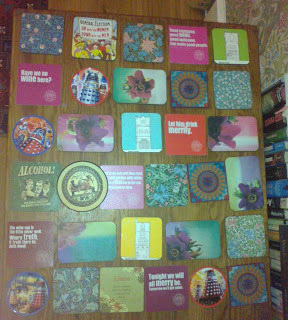
The above picture shows just a small part of my collection. You'll note the six Mr Benn ones aren't included - they're in a cupboard somewhere, along with the set showing specimens of ancient Greek sculpture and ones with quotations from Winston Churchill. You can see the thought that's gone into the selections: booze and Daleks suit me rather well, and designs by William Morris and the Greek stuff goes down well with the Dr. Those ones of buildings were hand illustrated by an architect chum and are really rather lovely. It would be churlish to be anything but grateful to have such thoughtful and generous friends.
And yet.
If I am defined as a Man With Coasters, it's because I already have them.
I worked for a internet start-up and the bubble hadn't yet burst, so for the first time in ever I had money in the bank. As well as showing off to my new girlfriend and taking her for meals in Pizza Express, I also bought an hilarious set of items for my new home with Nimbos.
Six coasters showing the roundel from the title sequence of Mr Benn.
I'd never owned coasters before and I still don't really see the point of them, but they were the pride and joy of that flat. They really tied the room together. People would call by our flat and comment on those coasters and we'd beam magnanimously back.
When I left that flat to move in with the Dr a year later, I took the coasters with me. People still commented on them, but more in the way on enquiring how long the Dr would put up with my all dorky nick-nacks. And then something very odd happened indeed. People started thinking of me as a Man With Coasters, and went and bought me more.

The above picture shows just a small part of my collection. You'll note the six Mr Benn ones aren't included - they're in a cupboard somewhere, along with the set showing specimens of ancient Greek sculpture and ones with quotations from Winston Churchill. You can see the thought that's gone into the selections: booze and Daleks suit me rather well, and designs by William Morris and the Greek stuff goes down well with the Dr. Those ones of buildings were hand illustrated by an architect chum and are really rather lovely. It would be churlish to be anything but grateful to have such thoughtful and generous friends.
And yet.
If I am defined as a Man With Coasters, it's because I already have them.
Published on February 13, 2013 09:59
February 2, 2013
Coming soon: Wizard, a film by the Guerrier brothers
A team of hardened professionals assembled in central London earlier today to make Wizard, the fourth short film by the amazing Guerrier brothers - coming to an internet near you in April, I should think. In the mean time, here are some jolly exciting pictures of people in an office, with helpful links to them on Twitter.
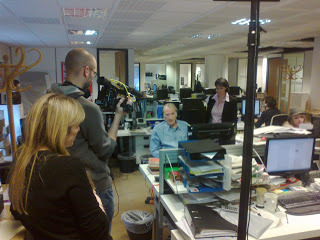 AD Natasha Phelan and director Thomas Guerrier film David Warner, Lisa Bowerman, William Hughes and Lisa Greenwood.
AD Natasha Phelan and director Thomas Guerrier film David Warner, Lisa Bowerman, William Hughes and Lisa Greenwood.
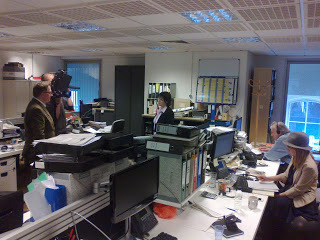 Matthew Sweet behind the camera with director Thomas Guerrier, filming Lisa Bowerman, David Warner and Lisa Greenwood.
Matthew Sweet behind the camera with director Thomas Guerrier, filming Lisa Bowerman, David Warner and Lisa Greenwood.
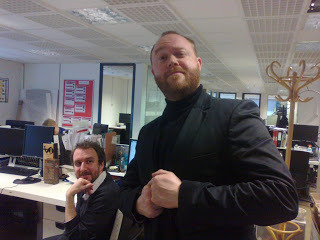 William Hughes photobombs the hirsuite Adrian Mackinder.
William Hughes photobombs the hirsuite Adrian Mackinder.
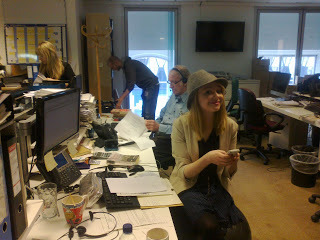 AD Natasha Phelan and director Thomas Guerrier with David Warner and Lisa Greenwood/
AD Natasha Phelan and director Thomas Guerrier with David Warner and Lisa Greenwood/
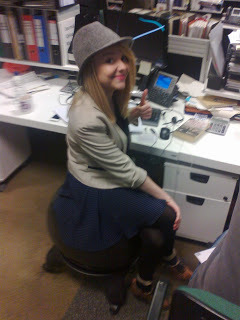 Lisa Greenwood demonstrates how to correctly sit on a spherical chair.
Lisa Greenwood demonstrates how to correctly sit on a spherical chair.
 Sound recordist Håvar Ellingsen, distracted from his
Queen and Country
.
Sound recordist Håvar Ellingsen, distracted from his
Queen and Country
.
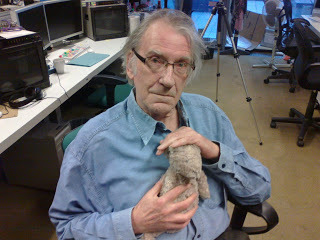 David Warner and co-star.
David Warner and co-star.
 The actor Matthew Sweet.
The actor Matthew Sweet.
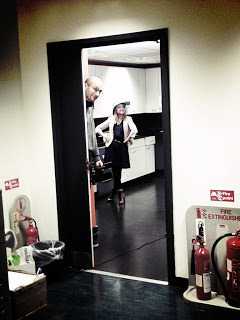 Director Thomas Guerrier and Lisa Greenwood preparing the all-important kitchen scene.
Director Thomas Guerrier and Lisa Greenwood preparing the all-important kitchen scene.
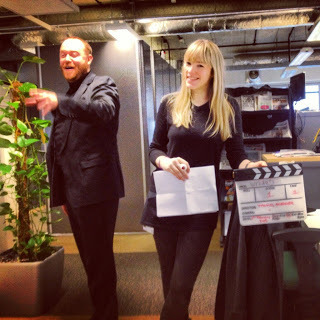 Adrian Mackinder and AD Natasha Phelan ready for a take.
Adrian Mackinder and AD Natasha Phelan ready for a take.
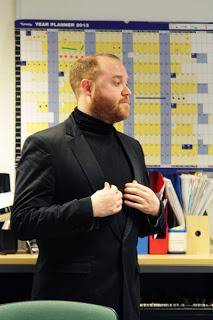 Adrian Mackinder, photo by Lisa Bowerman.
Adrian Mackinder, photo by Lisa Bowerman.
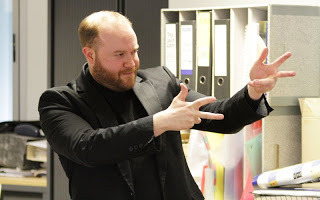 Adrian Mackinder and his moves, photo by Lisa Bowerman.
Adrian Mackinder and his moves, photo by Lisa Bowerman.
 David Warner and ready meal, photo by Lisa Bowerman.
David Warner and ready meal, photo by Lisa Bowerman.
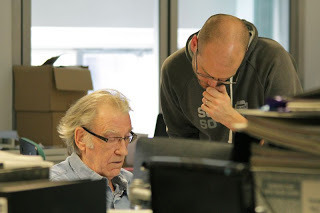 David Warner and director Thomas Guerrier attempt to make sense of the script, photo by Lisa Bowerman.
David Warner and director Thomas Guerrier attempt to make sense of the script, photo by Lisa Bowerman.
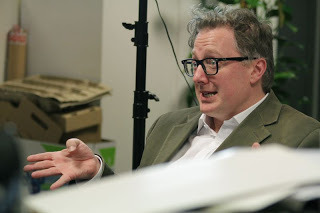 Matthew Sweet all eyes and teeth, photo by Lisa Bowerman.
Matthew Sweet all eyes and teeth, photo by Lisa Bowerman.
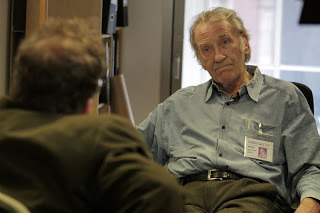 Matthew Sweet grills David Warner, photo by Lisa Bowerman.
Matthew Sweet grills David Warner, photo by Lisa Bowerman.
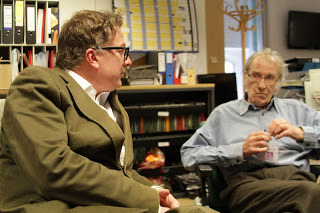 Matthew Sweet and David Warner, photo by Lisa Bowerman.
Matthew Sweet and David Warner, photo by Lisa Bowerman.
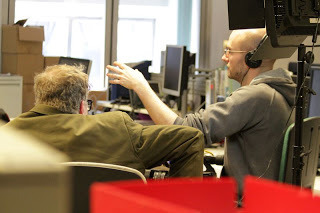 Matthew Sweet and director Thomas Guerrier, photo by Lisa Bowerman.
Matthew Sweet and director Thomas Guerrier, photo by Lisa Bowerman.
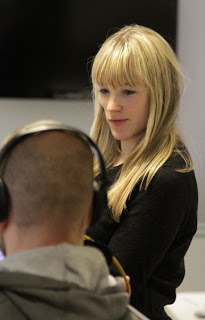 Director Thomas Guerrier and AD Natasha Phelan.
Director Thomas Guerrier and AD Natasha Phelan.
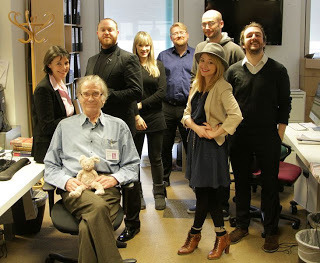 Team Wizard: Lisa Bowerman, David Warner, Adrian Mackinder, AD Natasha Phelan, sound recordist Håvar Ellingsen, Lisa Greenwood, director Thomas Guerrier and William Hughes.
Team Wizard: Lisa Bowerman, David Warner, Adrian Mackinder, AD Natasha Phelan, sound recordist Håvar Ellingsen, Lisa Greenwood, director Thomas Guerrier and William Hughes.
 Lisa Greenwood.
Lisa Greenwood.
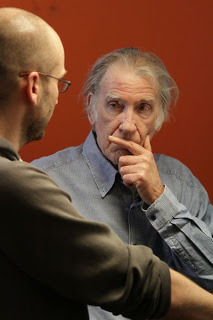 Director Thomas Guerrier and David Warner.
Director Thomas Guerrier and David Warner.
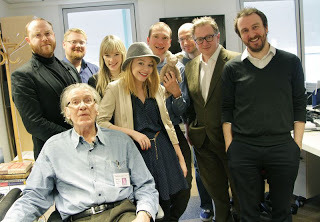 Team Wizard part II: Adrian Mackinder, sound recordist Håvar Ellingsen, David Warner, AD Natasha Phelan, Lisa Greenwood, me, Rabbit, director Thomas Guerrier, Matthew Sweet and William Hughes, photo by Lisa Bowerman.
Team Wizard part II: Adrian Mackinder, sound recordist Håvar Ellingsen, David Warner, AD Natasha Phelan, Lisa Greenwood, me, Rabbit, director Thomas Guerrier, Matthew Sweet and William Hughes, photo by Lisa Bowerman.
 AD Natasha Phelan and director Thomas Guerrier film David Warner, Lisa Bowerman, William Hughes and Lisa Greenwood.
AD Natasha Phelan and director Thomas Guerrier film David Warner, Lisa Bowerman, William Hughes and Lisa Greenwood.
 Matthew Sweet behind the camera with director Thomas Guerrier, filming Lisa Bowerman, David Warner and Lisa Greenwood.
Matthew Sweet behind the camera with director Thomas Guerrier, filming Lisa Bowerman, David Warner and Lisa Greenwood.
 William Hughes photobombs the hirsuite Adrian Mackinder.
William Hughes photobombs the hirsuite Adrian Mackinder.
 AD Natasha Phelan and director Thomas Guerrier with David Warner and Lisa Greenwood/
AD Natasha Phelan and director Thomas Guerrier with David Warner and Lisa Greenwood/
 Lisa Greenwood demonstrates how to correctly sit on a spherical chair.
Lisa Greenwood demonstrates how to correctly sit on a spherical chair.
 Sound recordist Håvar Ellingsen, distracted from his
Queen and Country
.
Sound recordist Håvar Ellingsen, distracted from his
Queen and Country
.
 David Warner and co-star.
David Warner and co-star.
 The actor Matthew Sweet.
The actor Matthew Sweet.
 Director Thomas Guerrier and Lisa Greenwood preparing the all-important kitchen scene.
Director Thomas Guerrier and Lisa Greenwood preparing the all-important kitchen scene. Adrian Mackinder and AD Natasha Phelan ready for a take.
Adrian Mackinder and AD Natasha Phelan ready for a take.
 Adrian Mackinder, photo by Lisa Bowerman.
Adrian Mackinder, photo by Lisa Bowerman.
 Adrian Mackinder and his moves, photo by Lisa Bowerman.
Adrian Mackinder and his moves, photo by Lisa Bowerman.
 David Warner and ready meal, photo by Lisa Bowerman.
David Warner and ready meal, photo by Lisa Bowerman.
 David Warner and director Thomas Guerrier attempt to make sense of the script, photo by Lisa Bowerman.
David Warner and director Thomas Guerrier attempt to make sense of the script, photo by Lisa Bowerman.
 Matthew Sweet all eyes and teeth, photo by Lisa Bowerman.
Matthew Sweet all eyes and teeth, photo by Lisa Bowerman.
 Matthew Sweet grills David Warner, photo by Lisa Bowerman.
Matthew Sweet grills David Warner, photo by Lisa Bowerman.
 Matthew Sweet and David Warner, photo by Lisa Bowerman.
Matthew Sweet and David Warner, photo by Lisa Bowerman.
 Matthew Sweet and director Thomas Guerrier, photo by Lisa Bowerman.
Matthew Sweet and director Thomas Guerrier, photo by Lisa Bowerman.
 Director Thomas Guerrier and AD Natasha Phelan.
Director Thomas Guerrier and AD Natasha Phelan.
 Team Wizard: Lisa Bowerman, David Warner, Adrian Mackinder, AD Natasha Phelan, sound recordist Håvar Ellingsen, Lisa Greenwood, director Thomas Guerrier and William Hughes.
Team Wizard: Lisa Bowerman, David Warner, Adrian Mackinder, AD Natasha Phelan, sound recordist Håvar Ellingsen, Lisa Greenwood, director Thomas Guerrier and William Hughes.
 Lisa Greenwood.
Lisa Greenwood.
 Director Thomas Guerrier and David Warner.
Director Thomas Guerrier and David Warner.
 Team Wizard part II: Adrian Mackinder, sound recordist Håvar Ellingsen, David Warner, AD Natasha Phelan, Lisa Greenwood, me, Rabbit, director Thomas Guerrier, Matthew Sweet and William Hughes, photo by Lisa Bowerman.
Team Wizard part II: Adrian Mackinder, sound recordist Håvar Ellingsen, David Warner, AD Natasha Phelan, Lisa Greenwood, me, Rabbit, director Thomas Guerrier, Matthew Sweet and William Hughes, photo by Lisa Bowerman.
Published on February 02, 2013 14:12
January 28, 2013
James Burke's Connections
First shown in 1978, James Burke's amazing 10-part history of science, Connections – an Alternative View of Change, is up on YouTube to watch in full. It's an extraordinary piece of work, full of brilliant insight and gutsy pieces-to-camera, such as this one that I've gibbered at before:
The main problem with science documentaries (having made a short one, “Entropy Explained”, that, despite a well-qualified and engaging presenter, I think doesn't quite work) is how to illustrate the argument without distracting from it. A personal bugbear is documentaries that show pretty pictures of space or CGI that aren't even connected to what's being said. At the same time, just having a talking head addressing the viewer can get dull very quickly – telly is all about moving pictures.
That's why Brian Cox gets sent all round the world, spelling out the science in a way that's visually appealing – and related to what he's saying (if also riffing off this). In the 1970s, Jacob Bronowski was commissioned to link science to art, which makes for better visuals in the amazing The Ascent of Man (1973). Later, Carl Sagan's Cosmos: A Personal Voyage (1980) dramatised lots of moments from history – and at great expense – while Carl himself hosted the show from the inside of spaceship (I can't help thinking it looks like the inside of the Pinky Ponk from In the Night Garden...).
But James Burke is quite the master at thrilling, engaging and boggling ways to put across his ideas. He cut his teeth presenting Tomorrow's World and the Apollo Moon landings. You can see a little of this early work at the BBC Archive's Tomorrow's World collection, while the excellent Apollo 11: A Night to Remember DVD features clips of Burke putting a spacesuit through its paces or testing the rocket escape system. All this shows his flair for simple and direct ways of talking technology in a way that we'll remember.
But Connections is something altogether more impressive: a 10-hour thesis on the history of and our dependence on technology.
The first episode reminds me, in terms of strategy, a little of 2001: A Space Odyssey (1968). That film consists of four separate but related stories: early man making a discovery; something happening on the Moon; something happening in a spaceship; a journey into the unknown. Each sequence is visually and aurally stunning, and each sequence ends with a startling, gosh-wow revelation that takes us somewhere new. As a whole, it aims to simply and vividly boggle our sense of where we come from, how we got here, and where we're going next.
Connections' first sequence is remarkably simple. Burke addresses us directly:
To make that case, Burke then spells out what happened in the New York City power blackout in 1965, dramatising scenes and speaking to witnesses. It's as fascinating for its depiction of human behaviour – passengers on a tube train sharing birthday cake and wine as they waited in a dark tunnel – as for the explanation of how a single protective relay caused chaos.
Burke shows us the offending relay before telling us what is, inviting us to guess. It's a very effective way of drawing us in. The point is that we are reliant on gadgets and networks we barely understand.
Next, he spells out a nightmare scenario of how long we'd survive in a world where technology stopped working, making the brutal choices horribly vivid – we'd need food and shelter, but would we be prepared to kill someone to take their house, or protect our own? Again, he gets in our heads, and plays to 70s concerns about how far we removed ourselves from the means of production and essential skills, played out earlier in Terry Nation's Survivors (1975-7).
But this is all merely a prelude. Burke is then in Egypt to trace the origin of our dependence on technology. I gather from my in-house expert that what follows is based on the work of the archaeologist Flinders Petrie.
About 10,000 BC, at a result of climate change, mankind's behaviour radically altered. Around this time, the glaciers receded and the temperature rose, and water became scarcer. The hunting nomads had to come down from the high grasslands in search of food, and did so, says Burke, in northern India, central America, Syria and Egypt (and possibly also Peru). In Egypt, where Burke bases his argument, they found a lucky accident of nature. A yearly flood of the river Nile created a very fertile ribbon of land stretching some 750 miles, in the midst of what was otherwise scrubland and desert. This fertile land supported plants the nomads could eat. About 5000 BC they settled permanently in the area. They dug and sowed crops, irrigating them by hand and perhaps with basic tools for nearly 1,000 years, and then an odd-shaped bit of wood transformed everything ever after.
Burke's explanation of what happened as a result of the invention of the plough is quite long but well worth following. It's a brilliant, eye-popping series of consequences, just as gosh-wow as 2001.
In each of the next eight episodes, Burke traces the discoveries that led to a key invention that he says define modern life – such as nuclear weapons, the space rocket and television. It's a shrewd and often very funny series drawing together myriad threads. Burke has a dry wit and love for historical irony. We learn, for example, that in the hunt for the cause of malaria (literally “bad air”), Napoleon ordered a bad smell map of Egypt.
I expect Douglas Adams was watching that first episode the night it was broadcast on 17 October 1978. He'd soon be working on a Doctor Who story about an alien who forced the progress of mankind. An episode first broadcast on 13 October 1979 – a little less than a year later – includes this from the alien:
Burke addresses himself to a straight male audience, and makes a whole load of other assumptions, too. At one point he asks us not to be distracted by a pretty girl in shot. Later, he asks us to recall his argument, “the next time your wife asks you to change a plug”. I imagine a few chums would find the patrician tone too condescending and arrogant, but that's a shame because there's so much to enjoy. For example, in discussing the Apollo programme and the criticism that it cost too much, he says, “in the same period, American women spent the same amount on cosmetics”.
But there are other things that seem from another age. For all this talk of technology feeding into our lives, computers are things that only affect us in the workplace. Yet when he talks about the relatively new-fangled credit card and how it will change “future” transactions, it seems prophetic. He explains in episode 8, that the credit card is more than just a substitute for cash. The magnetic strip on the back is a moral judgment on you, your life and your credit worthiness. The powers that make these judgments are secret and immutable, based on patented algorithms and business practices. More than that, they drive you to behave in certain ways which were, until recently, thought wholly immoral: encouraging you to live outside your means. As he says, chillingly, at the end of this sequence,
In episode 3, he argues that many inventions key to industrial development in the West – gunpowder, paper, magnets – had existed commonly in China for hundreds or even thousands of years. What made the West different, he says, is that China was a Taoist state, and believed that everything and everyone had their rightful place. In Europe, however, there was more social mobility and competition, so people were constantly looking for any advantage that might make them rich and lift them up the social order.
It's interesting to join that up with the BBC's other seminal, authored series of the time. Kenneth Clark in Civilisation (1969) argued the essential element for civilisation was the courtesy to discuss new ideas without fear of reprisals or death. Jacob Bronowski in The Ascent of Man made the case for knowledge over certainty – good evidence is key not just to science but law and history, too. To this, Burke adds opportunity which allows and encourages experiment and play, so that those who make discoveries or find new ways to apply them can fully reap the rewards. Effectively, without social mobility progress grinds to a halt.
Finally, in episode 10, Burke tries to sum up all we've seen: the surges of communications technology through letters, a postal system, telegraphy, satellite phones. He concludes that,
And yet Burke's also under no illusions about how difficult it is to predict the future. After all, the inventions he's covered in the series led to things no one could have predicted. And he concludes by connecting up the eight inventions from the series to one that will (he thinks) dominate our future – the bomber carrying nuclear bombs. Luckily, he was wrong.
There's a Not The Nine O'Clock News sketch that parodies Burke, with him telling us something, then contradicting it and then contradicting that contradiction. That's unfair, and though he does something a little like that in this last episode it's to make a serious point. He says he can't predict what will happen, or what developments will dominate our lives. In effect, he's saying, “It's more complicated than that” - itself a paraphrasing of all of science.
And he leaves us with something more potent and compelling than a dodgy prediction. Because the last moments of the series are an even more effective gosh-wow. Again, he directly appeals to us, telling us to become discoverers ourselves. He tells us that new discovery depends on challenging authority, religion and ideology that keep us in our place. As he says, science is sometimes seen as hard and emotionless because it “removes the reassuring crutches”. But he's not calling for some kind of revolution or new dawn of atheism. Instead, he simply spells out that all we need for progress is to ask the right questions.
The main problem with science documentaries (having made a short one, “Entropy Explained”, that, despite a well-qualified and engaging presenter, I think doesn't quite work) is how to illustrate the argument without distracting from it. A personal bugbear is documentaries that show pretty pictures of space or CGI that aren't even connected to what's being said. At the same time, just having a talking head addressing the viewer can get dull very quickly – telly is all about moving pictures.
That's why Brian Cox gets sent all round the world, spelling out the science in a way that's visually appealing – and related to what he's saying (if also riffing off this). In the 1970s, Jacob Bronowski was commissioned to link science to art, which makes for better visuals in the amazing The Ascent of Man (1973). Later, Carl Sagan's Cosmos: A Personal Voyage (1980) dramatised lots of moments from history – and at great expense – while Carl himself hosted the show from the inside of spaceship (I can't help thinking it looks like the inside of the Pinky Ponk from In the Night Garden...).
But James Burke is quite the master at thrilling, engaging and boggling ways to put across his ideas. He cut his teeth presenting Tomorrow's World and the Apollo Moon landings. You can see a little of this early work at the BBC Archive's Tomorrow's World collection, while the excellent Apollo 11: A Night to Remember DVD features clips of Burke putting a spacesuit through its paces or testing the rocket escape system. All this shows his flair for simple and direct ways of talking technology in a way that we'll remember.
But Connections is something altogether more impressive: a 10-hour thesis on the history of and our dependence on technology.
The first episode reminds me, in terms of strategy, a little of 2001: A Space Odyssey (1968). That film consists of four separate but related stories: early man making a discovery; something happening on the Moon; something happening in a spaceship; a journey into the unknown. Each sequence is visually and aurally stunning, and each sequence ends with a startling, gosh-wow revelation that takes us somewhere new. As a whole, it aims to simply and vividly boggle our sense of where we come from, how we got here, and where we're going next.
Connections' first sequence is remarkably simple. Burke addresses us directly:
“Would you do me a favour? I'd like to stop talking for a minute and when I do, take a look at the room you're in and above all at the man-made objects in that room that surround you – the television set, the lights, the phone and so on – and ask yourself what those objects do to your life just because they're there. Go ahead.”Watching it now, it's striking how much more dependent we are on clever telephonic and electronic devices since the series was made, so it makes the point even harder: we don't know how these things work and yet we're in their thrall.
To make that case, Burke then spells out what happened in the New York City power blackout in 1965, dramatising scenes and speaking to witnesses. It's as fascinating for its depiction of human behaviour – passengers on a tube train sharing birthday cake and wine as they waited in a dark tunnel – as for the explanation of how a single protective relay caused chaos.
Burke shows us the offending relay before telling us what is, inviting us to guess. It's a very effective way of drawing us in. The point is that we are reliant on gadgets and networks we barely understand.
Next, he spells out a nightmare scenario of how long we'd survive in a world where technology stopped working, making the brutal choices horribly vivid – we'd need food and shelter, but would we be prepared to kill someone to take their house, or protect our own? Again, he gets in our heads, and plays to 70s concerns about how far we removed ourselves from the means of production and essential skills, played out earlier in Terry Nation's Survivors (1975-7).
But this is all merely a prelude. Burke is then in Egypt to trace the origin of our dependence on technology. I gather from my in-house expert that what follows is based on the work of the archaeologist Flinders Petrie.
About 10,000 BC, at a result of climate change, mankind's behaviour radically altered. Around this time, the glaciers receded and the temperature rose, and water became scarcer. The hunting nomads had to come down from the high grasslands in search of food, and did so, says Burke, in northern India, central America, Syria and Egypt (and possibly also Peru). In Egypt, where Burke bases his argument, they found a lucky accident of nature. A yearly flood of the river Nile created a very fertile ribbon of land stretching some 750 miles, in the midst of what was otherwise scrubland and desert. This fertile land supported plants the nomads could eat. About 5000 BC they settled permanently in the area. They dug and sowed crops, irrigating them by hand and perhaps with basic tools for nearly 1,000 years, and then an odd-shaped bit of wood transformed everything ever after.
Burke's explanation of what happened as a result of the invention of the plough is quite long but well worth following. It's a brilliant, eye-popping series of consequences, just as gosh-wow as 2001.
“Initially the surplus [food] produced by irrigation and ploughing permitted non-foodproducers to operate within a community, and in the beginning these may have been the men who dug and maintained the irrigation systems, and those who organized them. These administrators would have derived their authority from their knowledge of astronomy which gave them alone the magic ability to say when the flood would come, when to sow on the land wet from the receding waters, and when to harvest. The grain needed storage room out of the weather, and dried clay daubed on woven reed baskets gradually gave way to more permanent containers as the demand for them increased with the crop. Fire-hardened clay pots, made from spiralling loops of wet earth, came to be used, and the first evidence of solid burning is of piles of these pots heaped together to form a form of central granary. The need to identify the ownership and amount of grain contained in a pot or a granary led to the development of writing. The first picture-words came from before 3000 B.C and comprise lists of objects and totals of figures contained in pots and chests. The surplus grain paid for craftsmen: carpenters, potters, weavers, bakers, musicians, leather-workers, metal-workers, and those whose task it was to record everything – the scribes. The need to ensure regularity of harvest in order to support those members of the community demanded a taxation system, and so that it should be operated fairly skills were developed to assess each man's due. Initially this may have started with the measurement of field boundaries destroyed each year by the flood, but as time passed and the irrigation systems grew more complex, the process demanded greater sophistication, calling for mathematics to handle the measurement of distance, area and cubic amount.
These early forms of arithmetic and geometry grew from the demands of canal building: how long, how wide and how deep? It may have been the need for tools to do the job which spurred interest in the copper deposits across the Red Sea in Sinai, and this in turn would have stimulated the use of metal for weapons. Weapons were needed by those whose task it was to protect the land and crops from invasion, as the surplus food and the goods financed by its production began to be used as barter with neighbouring communities, some of which looked with envy on the riches of Egypt. Metal tools gave the Egyptians the ability to work stone, initially, perhaps, in blocks for strengthening the irrigation ditches. The Nile is bordered for 500 miles south from Cairo by limestone cliffs, and it is from this stone that the first pyramid was constructed.
A mere hundred and fifty years after the first use of stone for the construction of buildings, the massive step pyramid of King Djoser was erected. It rises out of the desert as Saqqara, south of Cairo. Built by the king's chief minister, Imhotep, it is the oldest extant stone structure in the world, dating from around 2800 B.C. It was constructed using the tools and the theoretical knowledge developed by the canal builders, and it shows a high degree of precision in the use of both. By the time Djoser was being laid in his pyramid, Egyptian society had developed a form that is little changed today. At the top came the Head of State, served by his cabinet of advisers; these were aided by a civil service which organized every aspect of life in the state, gathering taxes from craftsmen and farmers to support themselves and the army. The regulation of the state's business was effected through the application of laws, which rested for their observance on the availability of an annual calendar, by now divided into twelve months or thirty days each. By 2500 B.C. the Egyptians (and their neighbours the Mesopotamians) had a developed and sophisticated society operating with a handful of essential tools: civil engineering, astronomical measurement, water-lifting machinery, writing and mathematics, primitive metallurgy, and the wheel. With these tools the Egyptians administered am empire whose power and influence was unparalleled in the ancient world, based on an agricultural output made possible by the plough. Its use had ensured the continued survival and expansion of the community and set in motion the changes that resulted from that expansion.
The first man-made harvest freed mankind from total and passive dependence of the vagaries of nature, and at the same time tied him for ever to the very tools that set him free. The modern world in which we live is the product of that original achievement, because just as the plough served to trigger change in the community in which it appeared, each change that followed led to further change in a continuing sequence of connected events.”
James Burke, Connections (Macmillan London Limited: 1978), pp. 10-12.The final sequence in this first episode sees Burke in Kuwait, showing how oil transformed the country in a single generation, so that people whose parents were nomads (as people were in Egypt before the invention of the plough) are now millionaires, racing through the desert in the latest Rolls-Royce. It's an awe-inspiring thesis, that a single invention or discovery can so transform our lives, and in ways the inventor or discoverer could never have predicted.
In each of the next eight episodes, Burke traces the discoveries that led to a key invention that he says define modern life – such as nuclear weapons, the space rocket and television. It's a shrewd and often very funny series drawing together myriad threads. Burke has a dry wit and love for historical irony. We learn, for example, that in the hunt for the cause of malaria (literally “bad air”), Napoleon ordered a bad smell map of Egypt.
I expect Douglas Adams was watching that first episode the night it was broadcast on 17 October 1978. He'd soon be working on a Doctor Who story about an alien who forced the progress of mankind. An episode first broadcast on 13 October 1979 – a little less than a year later – includes this from the alien:
SCARLIONI:
Achievement? You talk to me of achievement because I steal the Mona Lisa? Can you imagine how a man might feel who has caused the pyramids to be built, the heavens to be mapped, invented the first wheel, shown the true use of fire, brought up a whole race from nothing to save his own race?
“David Agnew” (David Fisher, Douglas Adams and Graham Williams), Doctor Who: “City of Death”, part three (1979)Connections is certainly of its time. Burke not unreasonably assumes the viewer remembers the launch of Apollo 11 and the stirring of emotions that went with it. There's the irony, for a series about technology, that he could never have predicted how this show would be watched or by who all these decades later. And in some ways it feels prehistoric.
Burke addresses himself to a straight male audience, and makes a whole load of other assumptions, too. At one point he asks us not to be distracted by a pretty girl in shot. Later, he asks us to recall his argument, “the next time your wife asks you to change a plug”. I imagine a few chums would find the patrician tone too condescending and arrogant, but that's a shame because there's so much to enjoy. For example, in discussing the Apollo programme and the criticism that it cost too much, he says, “in the same period, American women spent the same amount on cosmetics”.
But there are other things that seem from another age. For all this talk of technology feeding into our lives, computers are things that only affect us in the workplace. Yet when he talks about the relatively new-fangled credit card and how it will change “future” transactions, it seems prophetic. He explains in episode 8, that the credit card is more than just a substitute for cash. The magnetic strip on the back is a moral judgment on you, your life and your credit worthiness. The powers that make these judgments are secret and immutable, based on patented algorithms and business practices. More than that, they drive you to behave in certain ways which were, until recently, thought wholly immoral: encouraging you to live outside your means. As he says, chillingly, at the end of this sequence,
“What will happen when being in debt all the time is the normal way to live?”Burke is also good at looking for connections between the different stories and episodes, to understand what aids progress and what stands in its way.
In episode 3, he argues that many inventions key to industrial development in the West – gunpowder, paper, magnets – had existed commonly in China for hundreds or even thousands of years. What made the West different, he says, is that China was a Taoist state, and believed that everything and everyone had their rightful place. In Europe, however, there was more social mobility and competition, so people were constantly looking for any advantage that might make them rich and lift them up the social order.
It's interesting to join that up with the BBC's other seminal, authored series of the time. Kenneth Clark in Civilisation (1969) argued the essential element for civilisation was the courtesy to discuss new ideas without fear of reprisals or death. Jacob Bronowski in The Ascent of Man made the case for knowledge over certainty – good evidence is key not just to science but law and history, too. To this, Burke adds opportunity which allows and encourages experiment and play, so that those who make discoveries or find new ways to apply them can fully reap the rewards. Effectively, without social mobility progress grinds to a halt.
Finally, in episode 10, Burke tries to sum up all we've seen: the surges of communications technology through letters, a postal system, telegraphy, satellite phones. He concludes that,
“The faster you can communicate, the faster change happens.”He predicts – and more accurately than he could ever have imagined – that the near future would depend on,
“Information... what you do with the facts”.He argues that the defining question in the technological arms race will be,
“How easy is it for knowledge to spread?”He also says that lack of access to this information will equal powerlessness, just as if someone were deaf and dumb and blind. Watching it now, that all feels chillingly right.
And yet Burke's also under no illusions about how difficult it is to predict the future. After all, the inventions he's covered in the series led to things no one could have predicted. And he concludes by connecting up the eight inventions from the series to one that will (he thinks) dominate our future – the bomber carrying nuclear bombs. Luckily, he was wrong.
There's a Not The Nine O'Clock News sketch that parodies Burke, with him telling us something, then contradicting it and then contradicting that contradiction. That's unfair, and though he does something a little like that in this last episode it's to make a serious point. He says he can't predict what will happen, or what developments will dominate our lives. In effect, he's saying, “It's more complicated than that” - itself a paraphrasing of all of science.
And he leaves us with something more potent and compelling than a dodgy prediction. Because the last moments of the series are an even more effective gosh-wow. Again, he directly appeals to us, telling us to become discoverers ourselves. He tells us that new discovery depends on challenging authority, religion and ideology that keep us in our place. As he says, science is sometimes seen as hard and emotionless because it “removes the reassuring crutches”. But he's not calling for some kind of revolution or new dawn of atheism. Instead, he simply spells out that all we need for progress is to ask the right questions.
“Ask for explanations. And ask yourself if there's anything in your life you want changed.”I know what I'd like changed. I'd like a souped-up Region 2 DVD or Blu-Ray of Connections, please.
Published on January 28, 2013 06:08
January 26, 2013
Something really solid to bite on
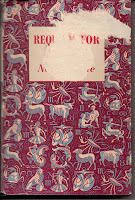 In a British Red Cross shop, the Dr found me a lovely 1956 World Books monthly edition of Nevil Shute's Requiem for a Wren (1955) - at least, it would have been if the price sticker hadn't torn the cover. I loved Shute's bleak tales of earnest people facing all the horrors that life can fling at them when I'd borrowed them from the shelves of my late grandfather's house.
On the Beach
(1957) is an especially extraordinary post-apocalyptic miasma of despair.
In a British Red Cross shop, the Dr found me a lovely 1956 World Books monthly edition of Nevil Shute's Requiem for a Wren (1955) - at least, it would have been if the price sticker hadn't torn the cover. I loved Shute's bleak tales of earnest people facing all the horrors that life can fling at them when I'd borrowed them from the shelves of my late grandfather's house.
On the Beach
(1957) is an especially extraordinary post-apocalyptic miasma of despair.In Requiem for a Wren, Alan Duncan (no, not the MP for Rutland & Melton) returns home to the family farm at Coombargana, outside Melbourne. Alan is a war veteran who lost both feet in a plane crash, but the shadow that really hangs over him is the death of his brother Bill, killed in Normandy helping to prepare for the invasion. Alan has spent the years since the war struggling to get used to his disability, and also trying to track down Janet Prentice, Bill's girlfriend who Alan met only once.
When Alan arrives home to the farm, he finds his elderly parents quietly distraught over the suicide of their maid. As Alan concludes late in the book,
"a war can go on killing people for a long time after it's all over."We follow Alan's efforts to piece together what happened to Janet, and failure to track her down. With Janet's faith in providence and justice, and the grief not merely for the war dead but also the excitement and freedom of the war, it reminded me a lot of Graham Greene's The End of the Affair (1951), and it has the same chilling bleakness that lingers long in the mind.
Nevil Shute, Requiem for a Wren (1955), p.246.
There's plenty to like here: the stark, no-nonsense prose, the eye for quirks of character and speech, even the way on page 216 Janet contracts contracts "it would" as "it 'ld" - with a space an an "l". She and the other Brits all speak in the clipped accents of In Which We Serve and A Matter of Life and Death, and are admired for their steely, practical manners through the conflict.
Throughout the book, it's underlined how much better it is to be doing things rather than dwelling on the past, and of the despair that sets in when there's nothing to be done. That's laid out early on, for instance, when we learn that Alan's younger sister,
"had picked up with a chap called Laurence Hilton who worked for the B.B.C. and put on plays for the Third Programme. She married him in 1947 and had not been home since; they had one child, rather an unpleasant little boy ... She seemed happy with [Laurence] and had adopted most of his views, including the one that Australia was a cultural desert that no decent person would dream of living in. His earning capacity, of course, was quite inadequate for the life they wished to lead. They have a very pleasant house in Cheyne Walk overlooking the river where they entertain a lot of visitors from ivory towers, and Coombargana pays.Much later we learn that Alan's sister felt little of the war's effect at home in Australia - if anything, the prospect of doing war work in industry gave her and her friends the excuse to escape home, live in the city and go to more parties. There is a gulf between them on Alan's first return home - her flighty and silly, he morose with his injury. That helps us to understand her and her choices, but it also comes late in the story and so doesn't redeem her.
I annoyed Laurence very much one day by referring to my father as a patron of the Arts. I'd probably have annoyed my father too if he'd known."
Ibid., p. 13.
In contrast, there's Janet, and Viola Dawson and the other girls Janet served with in the Wrens. Janet takes great pride in cleaning and expecting guns and ensuring everything works properly for when "the balloon goes up". She's also a very good shot - which is also the start of where things go wrong.
At one point, Janet is involved in what might be a case of friendly fire (Shute nicely makes the dilemma more difficult because we're never quite sure). In need of someone to talk to, and with Bill out on operations, Janet goes to see her father - an Oxford professor who missed serving in the first war but has just been called up to help with the Normandy landings. His glee over this means Janet can't bring herself to share her own woes. As she says, her father is having the time of his life:
"'You know,' he said in wonder, 'really - I believe I am. It's having to do with things, I suppose, after spending one's life dealing with ideas. It's having something really solid to bite on. Something definite to do."When Bill dies, his colleague Albert Finch writes to Janet to tell her. There are three short, matter-of-fact paragraphs - Albert isn't allowed to say how Bill died - and the last is that Albert will have to shoot Bill's dog unless Janet can find a place for it. Again, it's a blunt and practical concern, but it's an awful thing to put on her, and we really feel the pressure and guilt as she struggles to convince her superiors to let her keep a dog where she's stationed; we also feel the desperate relief when something gets arranged. Shute perfectly judges the awfulness of something so simple and real, and the whirl of emotions under the stiff upper lip.
Ibid., p. 108.
But there's also something darker going on about the shared experience of war. On Alan's first return home after the war, he's morbid and drinking too much. His father comes to meet him at the harbour to drive him back to the farm (it's a long way, but Alan is too fearful of flying). On the way, Alan's father matches his son's heavy drinking and they share war stories. It's a mark of understanding between them, a strong and male bond in the face of such horror. But it's also telling that for all he experienced in the first war, Alan's father was delighted by his son's both joining up.
Viola Dawson tells Alan,
"until we're dead, we Service people, the world will always be in danger of another war. We had a good time in the last one. We'll none of us come out into the open and admit it. It might be better for us, if we did. What we do is to put our votes in favour of re-armament and getting tough with Russia, and hope for the best ... For our generation, the war years were the best time of our lives, not because they were war years but because we were young ... Everyone looks back at the time when they were in their early twenties with nostalgia, but when we look back we only see the war. We had a fine time then, and so we think that if a third war came we'd have those happy, carefree years all over again. I don't suppose we would - some of us might."
Ibid., p. 185.
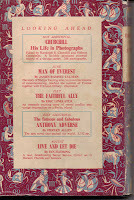 The ending is a little glib, and in the last two pages Alan turns things round to win the girl. It doesn't sit true with the bleakness of the rest of the book, and a note of uncertainty - that he hopes to win the girl but doesn't know if he can - would maybe have sat better. But apart from that, it's an enthralling, disturbing read.
The ending is a little glib, and in the last two pages Alan turns things round to win the girl. It doesn't sit true with the bleakness of the rest of the book, and a note of uncertainty - that he hopes to win the girl but doesn't know if he can - would maybe have sat better. But apart from that, it's an enthralling, disturbing read.I also liked the ad on the back cover for the next titles in the World Books monthly series. How strange to see a James Bond book being sold without mention of Bond.
Published on January 26, 2013 04:29
January 16, 2013
Dickens by Claire Tomalin
Claire Tomalin's biography of Charles Dickens is full of what George Orwell, speaking of Dickens' strengths, called the “telling detail”. There's the irony of this so-English author who called himself a citoyne of France. As so often, the reality is richer and more interesting than the myth. And there's a great deal of myth around Dickens.
As Simon Callow observed last year (the 200th anniversary of Dickens' birth),
Tomalin seems to like Dickens for his role in social reforms and she also appreciates some of his (male) characters, but generally she finds his work overwrought. The sense is that his books have been spoiled for her because of what she knows about his life.
She is also rather shocked at his ruthlessness to family, but he's given these people multiple chances and hand-outs, and generally they abuse his kindness and sense of duty. I felt more sympathy for a man whose relatives continually expect him to rescue them financially and abuse his patience. His struggles with money, and his need for an appreciative audience, struck a chord with this particular writer.
I wonder at Tomalin's own perspective as the wife of a famous novelist and playwright. There's no sense of the strange relationship with readers – for example that writing is painfully slow and lonely, yet a reader who responds will find the work immediate and intimate. I'd have liked more on his method: the volume of words per day, the number of revisions, his planning and ability to adapt his plans as a book progressed. It doesn't especially explain what made Dickens' work so different or appealing – either in his own time or today.
A BBC documentary last year dared suggest that Dickens' work invented the forms of early cinema. Given Tomalin's assessment of Dickens' amateur dramatics, I think its truer to say early film used lots of the forms of theatre, which was also an influence on him. His rich characters ache to be performed, his plots creaking under their strain. That often leads to actors hamming them up, but in the books themselves and the best adaptations, the more these larger-than-life people are played absolutely straight, the more effectively we will feel for all that they are put through. (That's why I think The Muppet's Christmas Carol is the best ever adaptation of Dickens: Muppets playing out a kitchen-sink drama absolutely straight is a perfect match for Dickens.)
Rather, Tomalin concentrates on conjuring the man himself, and it's a vivid and distinctive portrait. She paints Dickens as a hypocrite – the generous, jolly, social reformer is a predatory bully and bore. I think that's a little unfair on a hard-working man who lifted himself out of poverty and tried to help others too. That drive and purpose also makes this a difficult read: a man so full of energy and things to say withers away page after page, so many of his friends and family dying poor and prematurely. The story doesn't end with Dickens' death in 1870: Tomalin continues to explore his legacy and the damage wrought by his affair up until 1939, and the deaths of the last of his children. It's the shadow of a monster, not a cause of celebration. So it's a captivating book, but not a joy, and the monster not wholly convincing.
As Simon Callow observed last year (the 200th anniversary of Dickens' birth),
“Dickens the domestic monster has become part of the intellectual landscape, along with some increasingly lurid speculations about his sex life.”Callow spells out the evidence to the contrary, but Tomalin sticks to the "domestic monster" version, and details how the master of prose was expert at weaving convenient fictions round his misdeeds. A fantasist who treated those around him as if they were his own creations, it reads as a warning about the ego of writers.
Simon Callow, The Great Charles Dickens Scandal by Michael Slater – review, The Guardian, 23 November 2012.
Tomalin seems to like Dickens for his role in social reforms and she also appreciates some of his (male) characters, but generally she finds his work overwrought. The sense is that his books have been spoiled for her because of what she knows about his life.
“You want to avert your eyes from a good deal of what happened during the next year, 1858.”And yet I felt Tomalin was sometimes just as guilty as Dickens of massaging facts to suit a moral purpose. She indulges in conspiracy theories about Ellen Ternan – not merely whether Ternan and Dickens has sex, but whether Ternan had a son by Dickens (Tomalin spells out a tragic supposition where the child dies in France), and whether she was with Dickens when he suffered his last stroke. Tomalin presents what scant evidence exists for and against these claims, though makes her own beliefs plain - I thought not wholly convincingly. The truth is that we don't know: the evidence is too poor and a lot of it merely circumstantial. But having raised the possibility of a child with Ternan – and listed the historians who disagree – Tomalin then treats it as fact.
Claire Tomalin, Dickens, p. 294.
She is also rather shocked at his ruthlessness to family, but he's given these people multiple chances and hand-outs, and generally they abuse his kindness and sense of duty. I felt more sympathy for a man whose relatives continually expect him to rescue them financially and abuse his patience. His struggles with money, and his need for an appreciative audience, struck a chord with this particular writer.
I wonder at Tomalin's own perspective as the wife of a famous novelist and playwright. There's no sense of the strange relationship with readers – for example that writing is painfully slow and lonely, yet a reader who responds will find the work immediate and intimate. I'd have liked more on his method: the volume of words per day, the number of revisions, his planning and ability to adapt his plans as a book progressed. It doesn't especially explain what made Dickens' work so different or appealing – either in his own time or today.
A BBC documentary last year dared suggest that Dickens' work invented the forms of early cinema. Given Tomalin's assessment of Dickens' amateur dramatics, I think its truer to say early film used lots of the forms of theatre, which was also an influence on him. His rich characters ache to be performed, his plots creaking under their strain. That often leads to actors hamming them up, but in the books themselves and the best adaptations, the more these larger-than-life people are played absolutely straight, the more effectively we will feel for all that they are put through. (That's why I think The Muppet's Christmas Carol is the best ever adaptation of Dickens: Muppets playing out a kitchen-sink drama absolutely straight is a perfect match for Dickens.)
Rather, Tomalin concentrates on conjuring the man himself, and it's a vivid and distinctive portrait. She paints Dickens as a hypocrite – the generous, jolly, social reformer is a predatory bully and bore. I think that's a little unfair on a hard-working man who lifted himself out of poverty and tried to help others too. That drive and purpose also makes this a difficult read: a man so full of energy and things to say withers away page after page, so many of his friends and family dying poor and prematurely. The story doesn't end with Dickens' death in 1870: Tomalin continues to explore his legacy and the damage wrought by his affair up until 1939, and the deaths of the last of his children. It's the shadow of a monster, not a cause of celebration. So it's a captivating book, but not a joy, and the monster not wholly convincing.
Published on January 16, 2013 05:04
January 14, 2013
Shadow of Death and Logic
More of me that you can buy in shops. Next month,
Doctor Who: Shadow of Death
sees the Second Doctor and his chums on a remote world orbiting a pulsar. Frazer Hines is, as ever, utterly extraordinary at playing both the Doctor and Jamie, and narrating, while the magnificent Evie Dawnay plays a character I named after my GCSE astronomy teacher.
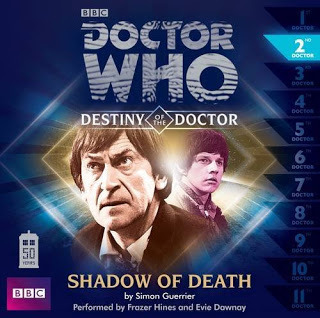
Then, in August, I have another Blake's 7 adventure: Logic. It's about Pol, an ordinary woman living an ordinary existence inside the domed city on Earth… until she is visited by strangers who bring chaos to her life. I'm thrilled that as well as starring Paul Darrow as Avon, Sally Knyvette as Jenna and Jacqueline Pearce as Servalan, my chum Louise Jameson stars as Pol. I wrote it with Louise in mind, and the nice people at Big Finish agreed she'd be perfect. Hooray!
Excitingly (or terrifyingly), Logic is part of a box-set so you'll also get Blake's 7 stories by Una McCormack and James Goss, too.

Then, in August, I have another Blake's 7 adventure: Logic. It's about Pol, an ordinary woman living an ordinary existence inside the domed city on Earth… until she is visited by strangers who bring chaos to her life. I'm thrilled that as well as starring Paul Darrow as Avon, Sally Knyvette as Jenna and Jacqueline Pearce as Servalan, my chum Louise Jameson stars as Pol. I wrote it with Louise in mind, and the nice people at Big Finish agreed she'd be perfect. Hooray!
Excitingly (or terrifyingly), Logic is part of a box-set so you'll also get Blake's 7 stories by Una McCormack and James Goss, too.
Published on January 14, 2013 06:56
January 11, 2013
Ch-ch-ch-changes
 A space lion from
A space lion from Doctor Who Adventures #302
- pic by John RossIssue #302 of Doctor Who Adventures , out in shops this very day, features a four-page comic strip written by me and illustrated by the amazing John Ross. In "All Change", shape-changing companion Decky Flamboon gets hiccups and keeps changing into more and more ridiculous things. It is all quite silly.
John, who's illustrated every one of the Doctor Who strips in more than 300 issues, has also just been interviewed by Down the Tubes about his work.
Published on January 11, 2013 04:18
Simon Guerrier's Blog
- Simon Guerrier's profile
- 60 followers
Simon Guerrier isn't a Goodreads Author
(yet),
but they
do have a blog,
so here are some recent posts imported from
their feed.



